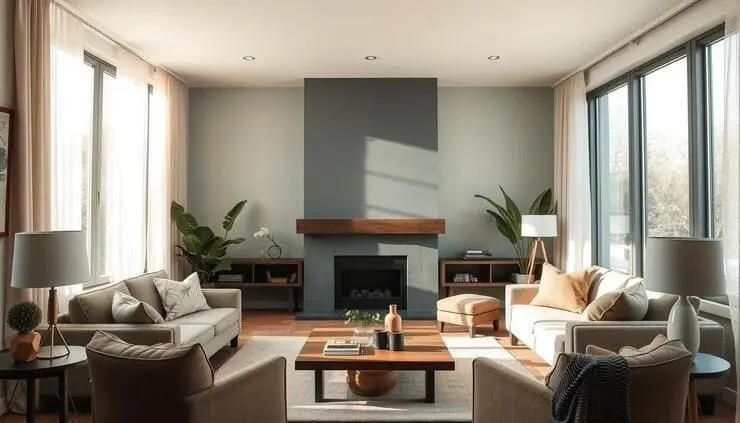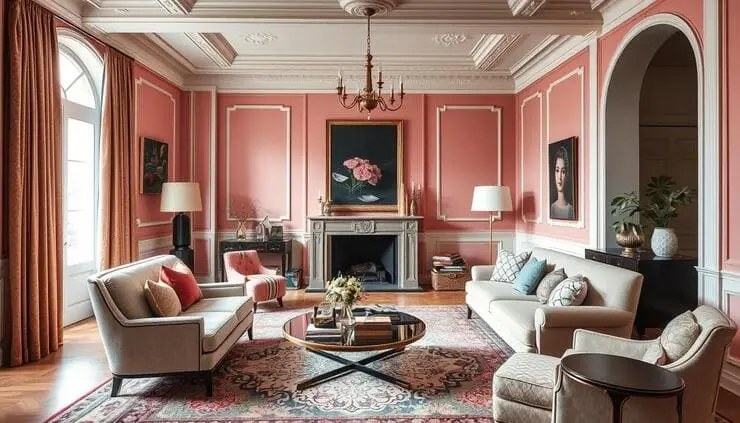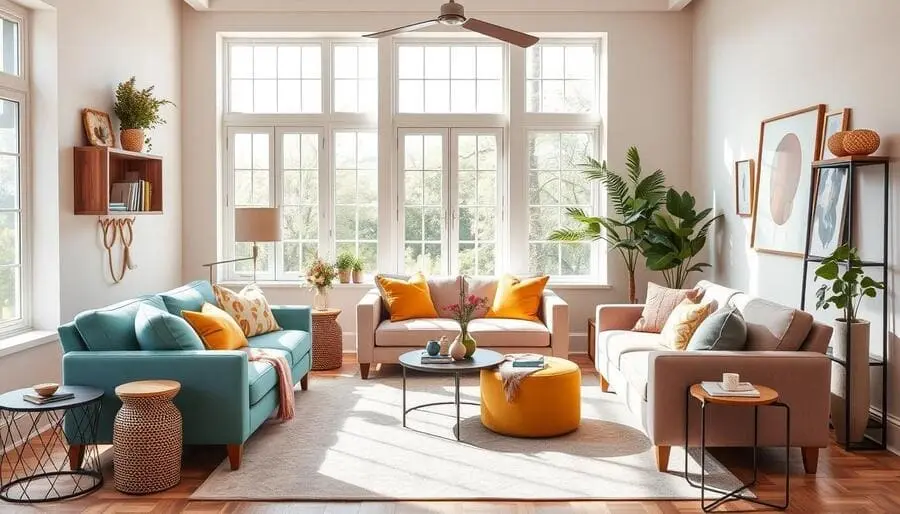As someone who loves interior design, I’ve seen how color can change our mood and feelings. Finding the right room color scheme is a big challenge. But, it can turn a dull space into a lively one.
Whether you’re updating your living room, bedroom, or home office, the right colors matter a lot. They don’t just look good; they also shape the room’s vibe, bring harmony, and even boost productivity. With so many colors to pick from, the choices are endless.
In this guide, we’ll dive into how to pick the perfect color scheme for any room. You’ll learn about color theory, using the color wheel, and more. These tools will help you create a space that reflects your style and improves your life.
Table of Contents
Key Takeaways
- Understand the fundamentals of color theory to make informed choices
- Leverage the color wheel to explore complementary, analogous, and triadic schemes
- Consider the impact of natural light and fixed elements on your room’s color palette
- Employ the 60-30-10 rule to achieve a harmonious balance of colors
- Avoid common color scheme mistakes and learn how to test colors in your space
Understanding Color Theory Basics for Interior Design
Learning the basics of color theory is key to making your rooms look amazing. It helps you pick the right colors for your home decor. Let’s dive into the basics that will unlock the power of color in any space.
Primary, Secondary, and Tertiary Colors
The color wheel is the starting point for color theory. The first three primary hues are yellow, blue, and red. Mixing these, we get secondary colors like orange, green, and purple. Then, there are tertiary colors, such as red-orange and blue-violet. Knowing how these colors work together opens up a world of possibilities for your room’s color scheme.
Warm vs. Cool Color Temperatures
Colors can be warm or cool. Warm colors, like reds and oranges, make us feel cozy and energetic. Cool colors, like blues and greens, are calming and sophisticated. Balancing these in your room’s color scheme can change the whole feel of the space.
Color Psychology in Home Decor
Color psychology is important in how we feel in our homes. For example, blues and greens can relax us, while reds and oranges can energize us. Knowing how colors affect us helps pick the right colors for your mood and style.
By learning color theory basics, you’ll create stunning and harmonious room color schemes. These will truly show off your personal style and preferences.
Essential Tools for Creating a Color Scheme for Room
Creating the perfect color scheme for room or room color palette can seem hard. But, with the right tools, you can make your dream come true. Discover the key resources that will help you try out, see, and pick the best color mix for your area.
The classic color wheel is a must-have. It’s digital or physical, and it shows how colors work together. It helps find matching colors and try out different looks. Many paint brands have online room painters. You can upload a photo of your room and see how different color scheme for room options look.
Color scheme generators online are also great. They look at what you like, your current decor, or a photo of your room. Then, they suggest room color palettes just for you. Sites like Adobe Color and Canva make it easy to find and save your favorite colors.
Don’t forget physical tools like paint chips, fabric swatches, and wallpaper samples. They’re key for creating your color scheme for room. Collect them and play with how they look together in your space. This hands-on way helps you make better choices and avoid mistakes.
| Tool | Description | Benefits |
|---|---|---|
| Color Wheel | A visual representation of color relationships | Helps understand color theory and identify complementary hues |
| Virtual Room Painter | Online tools that allow you to upload photos and experiment with different color scheme for room | Visualize how colors will look in your actual space |
| Color Scheme Generator | Online applications that suggest curated room color palette options | Provides inspiration and a starting point for your design |
| Physical Samples | Paint chips, fabric swatches, and wallpaper samples | Allows you to see and touch the colors in your space |
With these essential tools, you can confidently find and perfect the color scheme for room that shows off your style. Additionally, it will improve the appearance of your living area.
The Power of Color Wheel in Room Design
Discover how to create beautiful room color schemes with the color wheel. This tool helps you pick coordinating room colors that make any space look great.
Complementary Color Combinations
Complementary colors are like opposites that attract. Pairing colors like blue and orange or red and green makes a bold room color scheme. These colors create a striking contrast that grabs your attention.
Analogous Color Schemes
On the color wheel, analogous colors—such as blue, blue-green, and green—are adjacent to one another. These schemes offer a calm and soothing look. They make a space feel peaceful and serene.
Triadic and Split-Complementary Options
- Triadic color schemes use three colors equally spaced on the wheel, like red, blue, and yellow. This creates a lively and energetic room color scheme.
- Split-complementary schemes use one color and the two colors next to its complement. This approach is balanced and versatile for coordinating room colors.
Try out these color wheel-inspired room color schemes. Find the perfect colors that show off your style and design dreams.
Natural Light’s Impact on Room Colors
Designing the perfect room color palette or color scheme for a room is all about natural light. The color of your space changes a lot with the sunlight’s direction and strength.
Every room’s exposure – north, south, east, or west – changes how colors look. For example, a soft blue wall in a north-facing room might seem gray. But in a south-facing room, it could look bolder and more vibrant.
To make your room color palette shine, think about the natural light. Rooms with lots of sunlight do well with cool, muted colors. But rooms with little light need warmer, richer colors to brighten them up.
| Room Exposure | Color Appearance |
|---|---|
| North-Facing | Colors appear cooler and more muted |
| South-Facing | Colors appear warmer and more vibrant |
| East-Facing | Colors appear cooler in the morning, warmer in the afternoon |
| West-Facing | Colors appear warmer in the morning, cooler in the afternoon |
Knowing how natural light affects room color schemes helps you make better choices. You can create a space that looks great and fits your style perfectly.

RELATED : How to Paint a Room Like a Pro: Step-by-Step Guide
Starting with a Base Color: Tips and Techniques
Designing a room’s color scheme starts with a solid foundation. The right base color is key to a cohesive and appealing space. Whether you choose a neutral base or match your furniture, these tips will guide you to the perfect color scheme.
Selecting Neutral Foundations
Neutral colors like white, beige, gray, or black are great starting points. They offer a blank canvas for adding accents and secondary shades. Think about the mood you want in the room when picking a neutral base.
Building Around Existing Furniture
Love your furniture? Start by pulling colors from it. Match or complement the main colors of your sofa, chairs, or tables. This makes your room feel designed, not random.
Working with Fixed Elements
Fixed elements like flooring or architectural features can guide your room color scheme. Choose colors that enhance or complement these features. This creates a harmonious space.
Build from a strong foundation first. Layering colors, textures, and patterns thoughtfully creates a stunning room that shows off your style.
Popular Color Combinations for Different Room Types
Choosing the right color scheme for room or room color palette is key. Every room has a distinct function and atmosphere. The right colors can change a room’s whole vibe. Let’s look at some top color schemes for different rooms.
Living Room Color Schemes
In the living room, mixing neutrals with bold colors works well. Try a soothing mix of grays, taupes, and whites with jewel-toned blues, deep greens, or rich reds. This makes the room feel welcoming and lets you add your own style with accessories.
Bedroom Color Palettes
The bedroom should be calm and peaceful. Opt for soft colors like pale blues, dusty pinks, or warm beiges. Adding natural elements like wood and plants makes it even more relaxing.
Kitchen Color Combinations
Kitchens are perfect for bright, lively colors. White, yellow, and blue make the space feel open and cheerful. Or, try earthier tones like terracotta, olive green, and warm neutrals for a cozy feel.
Bathroom Color Schemes
Bathrooms should feel fresh and clean. White, soft blues, and calming greens create a spa-like atmosphere. Or, go for grays or beiges for a timeless, elegant look.
When picking a color scheme for room or room color palette, think about the room’s use, your style, and the mood you want. Try out different colors and don’t be shy. The perfect color scheme is just around the corner!
Creating Balance with the 60-30-10 Rule
Creating a harmonious room color scheme is all about balance. The 60-30-10 rule is a great way to achieve this. It suggests using 60% of your room’s color for a main hue, 30% for a secondary color, and 10% for accents.
Distribution of Primary Colors
The main 60% of your room’s color should be the base. It sets the tone and mood. This could be a neutral like beige or a bold shade like deep blue. Make sure this color is in big furniture, walls, and key textiles for a unified look.
Accent Color Placement
The 10% accent colors add fun and personality. They could be bright throw pillows, a patterned rug, or a shiny lamp. Placing these accents smartly around the room creates interest without overwhelming the design.
| Color Allocation | Examples |
|---|---|
| 60% Primary Color | Walls, large furniture, major textiles |
| 30% Secondary Color | Accent pieces, smaller furnishings |
| 10% Accent Color | Décor, lighting, artwork |
Learning the 60-30-10 rule is crucial for a balanced room color scheme. It helps mix bold colors with softer coordinating room colors. By using this rule, you’ll get a stunning and well-balanced space.
Common Color Scheme Mistakes to Avoid
Creating the perfect color scheme for room can be tricky, even for experts. It’s important to avoid common mistakes to get a beautiful room color palette. Let’s examine several blunders to steer clear of.
One big mistake is using too many colors in one room. While it’s fun to mix things up, too many colors can be overwhelming. If you want a balanced look, stick to three to five hues.
Another mistake is ignoring undertones. Colors have warm or cool undertones that change how a room feels. Not considering these undertones can make your room color palette feel off.
Lighting is also key when picking a color scheme for room. What looks great in the store might not in your home. Always test colors in your space to see how they look under your lighting.
- Avoid using too many colors in a single room
- Consider the undertones of each hue
- Evaluate colors in the specific lighting conditions of your space
By avoiding these mistakes, you can create a room color palette that makes your space look great. It will be welcoming and harmonious.

Testing and Sampling Colors in Your Space
Finding the right room color scheme can be tough. But, testing and sampling are key to getting it right. They help you avoid mistakes and make a space that shows off your style.
Paint Sample Techniques
Begin by getting many paint samples. To see how they appear, apply them to your walls. Make sure to test them in different parts of the room. The color can change based on where you are.
Lighting Test Methods
Lighting affects how colors appear. So, test your samples under different lights. Check them in daylight, at night, and under artificial lights. This ensures the colors work well in all lighting.
Digital Design Tools
- For a tech-savvy approach, use digital design tools. They let you see room color schemes before painting. You can upload your room’s photos and try out colors virtually.
- This is great for matching colors with your furniture or decor.
By carefully testing and sampling colors, you can be sure of your room color scheme. This way, you’ll create a space that looks good and shows off your style.
Conclusion
Exploring color theory and design has given you the tools to create the perfect color scheme for any room. You now understand primary, secondary, and tertiary colors. You also know how to balance warm and cool tones.
This knowledge lets you turn your living spaces into vibrant, cohesive havens. These spaces will reflect your personal style.
Creating a successful color scheme for room is all about experimenting and trusting your instincts. The principles and techniques from this article are a solid start. But, the real magic happens when you apply them to your unique space and preferences.
Don’t be afraid to try bold room color palette combinations. The most captivating designs often come from embracing the unexpected.
As you start your color journey, stay open-minded and adaptable. Trust your own creative vision. With what you’ve learned, you’re ready to elevate your living spaces. You’ll create environments that inspire and delight you every day.


1 thought on “Room Color Scheme : How to Choose a Perfect Combination”